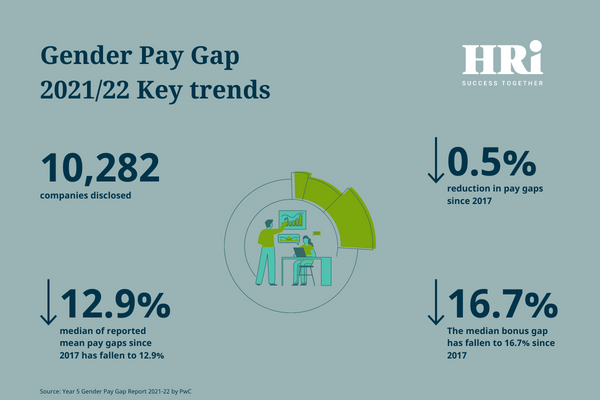Latest from HRi
Gender pay gap – what does a slow rate of change mean?
2022 marks the fifth year of gender pay gap reporting. It became mandatory for UK companies with over 250 employees in 2017.
Earlier this week, PwC released an analysis of gender pay gap data. 10,282 companies disclosed their data this year, 22% more companies compared to last year (8,456). Whilst it is encouraging to see that more businesses are reporting on gender pay gap, it is disappointing to see that as high as 43% of the companies that disclosed their data reported an increase in their gender pay gap. 53% reported a decrease and 4% reported no change.
There has been 0.5% reduction in pay gaps since 2017. The figures showed that there has been a small decline of 0.3% in the average pay gap of 13.2% in 2020/21 to 12.9% in 2021/22. This means on average, women in the UK earn 87p for every £1 men earn.
Gender pay gap by sector
The change in pay gap was also evident across sectors. Financial Services, including Banking (28.9%) and Investment (25.7%), continue to have some of the highest average pay gaps, with less than 2% reduction in the average gender pay gap in in 2021/22. However, the mining (decrease of 5.4% to 17%), energy (decrease of 3.4% to 17.5% and real estate (decrease of 3.1% to 25.1%) sectors reported the biggest decrease in pay gap. Agriculture companies (increase of 4.6% to 13.2%) and travel (increase of 3.9% to 17.6%) reported the biggest increase.

Gender Bonus Gap
PwC reports that 52% of companies have reported a reduction in their average bonus gap compared to 53% the year before, reporting a decrease in the last year. The national average gender bonus gap is 32.5%.
The slow rate of change raises concerns about businesses ability to make effective changes in this area. Challenges businesses have faced in the last 2 years due to the global pandemic may have pushed gender pay gap further down the agenda for boards. Gender pay gap has not received the level of attention and activity it deserves.
Additionally, women were disproportionately impacted during the lockdown, with most women assuming the responsibility for home schooling of their children and care of relatives. Whilst some were able to maintain a good work-life balance, it was difficult for many. This may have had knock on impact on their careers and affected their promotion and pay rise. Thus, increasing gender pay gap for many companies.
Gender pay gap is further compounded post pandemic by the cost-of-living pressures due to high inflation, low growth economic predictions and business restructuring.
What can organisations do to improve the narrowing of the pay gap?
The Mckinsey’s diversity wins report showed that gender diverse organisations are 25% more profitable. With organisations operating in difficult conditions, including attracting and retaining talent, and high business operating costs, it is therefore, essential for businesses to get their gender diversity balance right at all levels to enable them to gain competitive advantage and to be more profitable. Organisations must approach gender diversity and bridging gender pay gap as active strategies to make them sustainable.
Five Positive steps towards achieving gender pay equity:
1. Recruitment – organisations must design their recruitment process to attract women to all levels of their organisations. Salaries offered for roles should reflect the job post. All applicants must be offered salaries based on their experience, qualifications and skillset, not on their gender.
2. Talent Development – organisations should offer development opportunities to female employees. These opportunities should be available to both part-time and full-time employees.
3. Promotion – to bridge the gap at senior levels, organisations must reduce barriers to entry for female applicants. They must be offered support such as mentoring and coaching. This will help boost their confidence.
4. Boards must adhere to targets for addressing gender pay gaps in their organisations.
5. Organisations must become more transparent with their pay and rewards strategies.
Author: Mary Asante, Director | HRi
